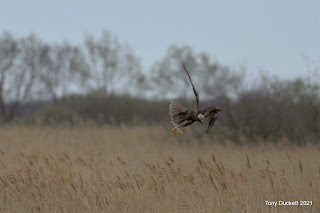Norfolk early May 2021
Well yet again this spring Norfolk was very quiet. Water levels on the east side of the county were very high, making it unattractive to wader. This is the first time in years that I haven't seen any Little Egrets or Great White Egrets. I only visited so called Broadland hotspots but these sites would normally have them. Common spring migrants were few, with only 3 Wheatears and 1 Whinchat, a Golden Oriole sang for 5 minutes from woodland near Rush Hill Scrape but then went silent. I presumed it moved off as I never heard it again and it wasn't reported by anybody else. Common Swifts, Swallows and House Martins numbers slowly increased during my stay but numbers were so low.
We quite enjoy having a pair of Red-legged Partridges visiting our garden. Their call/song carries a very long way, the female is busy laying eggs and visits less often as you would expect.
I visited Kelling Heath early one morning and was greeted by a family of Crossbills
The reason for going to the heath was hopefully to see Dartford Warblers and Woodlark. I succeeded with one but not a squeak from the other. I cannot recall seeing Dartfords singing from the top of a tree before.
One afternoon I walked along Weavers Way an ancient path on the southern bank of Hickling Broad. I could here Bitterns booming when something in the distance caught my attention. The views were fine through binoculars but taking it's photo was a different matter. I carried on and arrived at Rush Hill Scrape and was greeted to again distant views, that's the trouble with this site, a nice hide but views are crap. Anyway in the distance yesterdays Black Tern was still hawking insects, nobody had reported it today.
If only the Black Tern was as close as this Common Tern, same location different feeding methods.
One morning we had a walk along my favourite stretch of coast, as we got out of the car the sound of Little Terns could be high overhead. Their display flights are great to watch as males chase females with a sand eel in their beaks. Once I the beach we were greeted to a team of RSPB workers and volunteers erecting fencing to protect the birds during the breeding season.
Several pairs of Marsh Harriers nest and hunt in this area, at the moment there are families of Greylags with recently hatched goslings. The geese aren't as agile as the Shelducks who really give the harriers a hard time if he comes anywhere near.
Interesting passage migrants were very thin on the ground, this male Whinchat was a little stunner, The male Wheatear wasn't bad either.
The next six species; Skylark, Linnet, Reed Bunting, Sedge Warbler, Goldfinch and Blackcap were singing from prominent perches which was difficult in such breezy conditions/
Little-ringed Plover displaying over a flooded area of Hickling NWT Reserve, he was joined by an Oystercatcher and a this Lapwing who landed before I could get a photo.
Two drake Garganey were nice to see.












































Comments